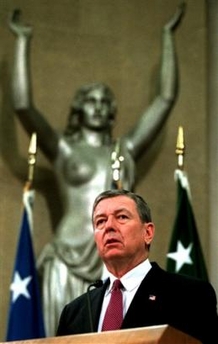Just when we thought it was safe to go back on the internet,
The Manila Times publishes another column by Dr. Edgar Escultura. Once again Escultura is claiming that he has refuted Dr. Andrew Wiles' proof of Fermat's Last Theorem (FLT). We have six previous posts at Don't Let Me Stop You on this topic, so it is at considerable risk of beating our own dead horse that we embark upon a seventh. The
most recent post has links leading to the others. Alternatively, use the Google or Technorati search boxes on this page and "Fermat" to find the entire list.
Before we get into the "meat," such as it is, of Escultura's arguments let's cover some background information. The
Wikipedia article on FLT is a good, general review of the history of the topic. Wikipedia articles are "living" documents, and readers may submit additions/corrections to any article. The editors for that page then decide whether or not to incorporate the suggestions. A review of the "Discussion" and "History" tabs for the Wikipedia page shows that the editors have explicitly rejected Escultura's claims.
The equation of FLT is: x^n + y^n = z^n
where x, y, z and n are all variables representing positive integers (1, 2, 3, 4, ...). The "^n" notation indicates that "n" is an exponent (e.g. x^2 = x * x; x^3 = x * x * x; etc.). For n = 1 it is easy to find x, y, z groups that satisfy the equation. For n = 2 we have the Pythagorean Theorem, relating the lengths of the sides of right triangles. There are groups of x, y, and z that satisfy the equation for n = 2. For example 3, 4, 5 -> 9 + 16 = 25, which is true.
Fermat suggested that for n = 3 or greater, there are no groups of x, y, and z for which the equation is true. He proved it for n = 4, and proofs have been made for some other specific values of n, but the general case (n = 5, 6, 7, ...) remained unproven for 357 years. Since there are an infinite number of values of "n" to examine, and for each "n" an infinite number of x, y, z groups to examine, proving the general case is obviously difficult.
Note also that there are two separate issues at stake here:
- Is FLT true?
- Is the proof of FLT supplied by Wiles and Richard Taylor valid?
If an error in the Wiles and Taylor proof were found, the proof would be invalidated, but FLT itself might still be true. It would merely be, once again, unproven. Indeed, an earlier proof in 1993 by Wiles and Taylor was found to contain an error. The revised proof, published in 1994, overcame that problem.
On the other hand, if a single set of x, y, z (positive integers) and integer value of "n" greater than 2 can be plugged into the equation and give a true result, then FLT itself would be proven false. In such a case it would be clear that there must be an error somewhere in the Wiles/Taylor proof of FLT, and it would only be a matter of finding it.
With that completed we move on to what Dr. Escultura says in his latest
Manila Times column:
"The central issue here is whether FLT is true or not. The answer is quite categorical: it is false. This is established by countable counterexamples published in several renowned journals, particularly, Nonlinear Studies, Vol. 5, No. 2, September 1998, pp. 227-254. Those who understood the issue including most mathematicians refuted neither the conclusion nor the counterexamples."
So Escultura claims that FLT itself is false, and that he has "countable counterexamples" that establish this. We can't see the significance of "countable" in this, but whatever. A single group of integers (n, x, y, and z) that fit the equation would refute FLT, definitively, forever. So why does he not provide a single example from his "countable counterexamples" in his column? Four integers is all it would take. Where are they?
"Andrew Wiles came into the picture only because he earlier claimed that he had proved this conjecture. He published his work in Johns Hopkins University's Annals of Mathematics, 1995, a local US publication. The counterexamples proved that (a) FLT is false, (b) Wiles is wrong, (c) Fermat's conjecture is false and (d) the Annals of Mathematics erred in publishing Wiles' erroneous proof."
So
Nonlinear Studies is a "renowned journal," while
Annals of Mathematics is just "a local US publication," according to Dr. Escultura. We note that NS has been published since 1993 and is located in Daytona Beach, Florida. On the other hand AoM has been published since 1884, giving it a 109-year headstart on earning "renown" among "local US publications." The online archiving and indexing service for scholarly journals,
JSTOR, selects the best journals in a wide variety of scientific disciplines. They don't cover NS, but
JSTOR says about AoM, "It is widely regarded as one of the main mathematics journals in the world." Readers are invited to follow the links to each journal's site for further information.
We note that AoM has not published any retraction/correction of Wiles and Taylor's paper in the 6 1/2 years since Escultura's paper. If the NS paper discloses any groups of four integers that represent counterexamples to FLT, it has certainly taken quite awhile for mathematicians around the world to plug them into their calculators.
Escultura continues:
"Wiles' admission of error registered on my guess [sic] book confirmed by two more messages of his and reinforced by a message from Wiles' former collaborator, Richard Taylor, was a graceful exit and a bonus to the resolution of FLT. It neither adds to nor subtracts from the resolution of FLT. However, those who did not understand the issue but were disappointed by this turn of events raised a side issue: whether the message was a hoax. They had hoped for a disclaimer from Wiles that never came."
He is still claiming, with no evidence whatsoever, that anonymous entries in his web site guest book are from Wiles. As we noted
previously, anyone can post there under any name they select. In fact, a specific denial from Wiles did come in email correspondence with
Alecks Pabico.
Not everyone was pleased by this outcome. Mr. A. Pabico of the Philippine Center for Investigative Journalism, a small outfit at the University of the Philippines, called me posing as a mathematical enthusiast. The first few words of our conversation quickly revealed he wasn’t; he was fishing for some skeleton in my closet. Unsuccessful, he pointed to a typo and an error in detail in Rony Diaz’s May 5 article on FLT in The Manila Times as major mathematical blunder. He used them as basis of an article in the PCIJ website entitled, “Anatomy of a Hoax,” where he claimed that Wiles e-mailed him a disclaimer. What? Andrew Wiles sending a disclaimer to a total stranger who is not even a mathematician?
This seems to us a gross mischaracterization of
Pabico's article, but judge for yourself whose writing is more credible. In any case, Pabico contacted Wiles by email at an address from the Princeton Univ. website. They exchanged several messages, and Wiles categorically denied being the author of the entries in Escultura's website guestbook. Escultura seems to suggest some imposter might have broken into Wiles' email account at Princeton, intercepted all of Pabico's messages, and sent forged replies for the sole purpose of preventing Wiles from authenticating the guestbook entries. Since Pabico initiated the contact with Wiles through a Princeton email address, this information is as good as Pabico's word, which is far better than any anonymous guest book entry.
Escultura then attempts to authenticate the previous, obviously forged, "Wiles" guestbook entries with this, obviously forged guestbook entry:
"As a former collaborator of Andrew Wiles (on the FLT proof) I have to congratulate you with your spectacular discovery. Andrew and I are of course delighted to acknowledge you as a far greater luminary of science than we could ever hope to be. We kneel before you in humbleness and would be honored to offer you our feeble efforts in further developing your alternative theory of mathematics and FLT. Sincerely, R. Taylor"
Give us a moment here to stop laughing and catch our breath. There, that's better. What's next, a guestbook entry from Pierre de Fermat himself affirming Escultura's brilliance? The failure of Fermat to disclaim the entry can then "prove" that it's authentic.
We will skip the rest of Escultura's article, which describes his alternative mathematics system. We will note, however, that Escultura's "refutation" of FLT is only valid in the special mathematical universe he has created, at best. Since FLT is cast in the standard number system, disproving it by changing the rules is not much of a feat.
P.S. We thought this story couldn't get any wackier, but then we re-read the comments thread with
Alecks Pabico's article. The Manila Times has just published an article saying
Escultura has been nominated for a Nobel Prize in physics:
"TWO members of the Royal Swedish Academy of Sciences confirmed in separate messages that Prof. Edgar E. Escultura has been nominated for the 2005 Nobel Prize for Physics.
Dr. Johannes Hieber told Escultura that 'we have read your work on the Grand Unified Theory and deem it worthy of a nomination for the Nobel Prize for Physics.'
Dr. Lars Jonhagen in an e-mail that Escultura received on June 15 said: 'You, sir, have demonstrated such a high level of understanding of Physics and, as such, your nomination is very special.'
At this point we're betting these "messages" from the Academy were actually posted in his "guess book." Reading between the lines here, it seems that once again Escultura is the sole source the Manila Times contacted about the claim.
Technorati: Wiles, Fermat, Escultura, mathematics, hoax, press misconduct, Manila Times





